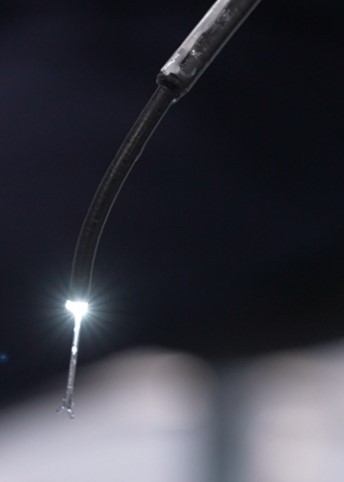Metal 3D printing technology from Bright Laser Technologies (BLT) has played a key role in the production of the world’s first flexible robotic system for minimally invasive brain surgery.
This robotic system, dubbed the MicroNeuro, was developed by a team from the Centre of Artificial Intelligence and Robotics (CAIR) of the Hong Kong Institute of Science & Innovation, Chinese Academy of Sciences.
MicroNeuro reportedly integrates a number of novel technologies including multilevel flexible endoscopy, high precision control, augmented reality surgical navigation and artificial intelligence (AI). ‘Digital twin’ capabilities are also offered, enabling real-time matching of the brain tissue structure and surgical tools, making the surgical process more intuitive.
These technologies are said to address challenges associated with fragile brain tissue and limited space, as well as overcoming the limits of hand-eye-brain operation.
The BLT-A160D metal 3D printer was leveraged to 3D print the multifunctional distal head caps for the MicroNeuro. These components were 3D printed in SUS 316L stainless steel. The BLT also completed the post-processing of the parts and supported the R&D phase.
“BLT’s integrated additive manufacturing solution has significantly streamlined the design of MicroNeuro, enhancing its convenience, flexibility, and structural compactness,” commented a member of the CAIR engineering team.
“In the future, we hope to continue to promote the application of metal 3D printing technology in our other research projects and foster even closer collaboration with BLT.”
 MicroNeuro: the flexible robotic system for minimally invasive brain surgery. Photo via Bright Laser Technologies.
MicroNeuro: the flexible robotic system for minimally invasive brain surgery. Photo via Bright Laser Technologies.
BLT 3D printing pivotal in MicroNeuro production
According to CAIR engineers, the 3D printed multifunctional distal head caps are key to the MicroNeuro’s function, serving the “vital purpose of fixing and installing image units, lighting units, instrument channels, and other components.” Force sensing functionality has also been integrated into a 3 mm outer diameter endoscope, whilst optical fibers need to be fixed to the tip.
The head caps are also said to feature an intricate design, with wall thicknesses as low as 0.15 mm. Such features would be difficult to achieve using conventional methods.
Manufacturing on Demand
The BLT-A160D, a two-laser metal 3D printer possessing build dimensions of 160mm x 160mm x 100mm, was used to fabricate these parts. According to BLT, the high throughput capabilities of this 3D printer enabled the production of 1190 pieces of multifunctional distal head caps in just five hours. Consistent product quality was reportedly achieved across various batches of full-plate 3D prints across multiple BLT-A160D systems.
What’s more, BLT’s post-processing polishing ensured that all surface roughness requirements were met. The BLT team worked during the R&D phase to help achieve rapid verification of fine structures based on user requirements. Ultimately, the mass produced distal structures were 3D printed with high efficiency, at a low cost, and to a consistently high standard, the company claims.
BLT has also reportedly played a vital role in assisting the development of other critical components such as flexible endoscopes, multi-cavity rigid sheath endoscopes, and heterotypic water guide tubes.
Looking to the future, the CAIR team stated that irregular channels such as flushing lenses and suction irrigation may need to be integrated into the multifunctional distal head. They claim that metal 3D printing is the only low-cost, high-precision method capable of producing such a part.

Optimizing medical procedures with 3D printing
The use of additive manufacturing continues to grow as a key technology in optimizing medical procedures. Indeed, this is not the first time BLT has made headlines in this field.
Later last year, it was announced that the company’s 3D printed spinal implants had received market approval in China. Developed in collaboration with medical firm Wedo Bio-Medical Technology, these WedoCage implants were produced using BLT’s BLT-S210 and BLT-S310 metal 3D printers.
Following controlled clinical trials, these 3D printed implants were found to have a fusion effective rate of 97.10% at six months. This surpasses the 85.29% fusion succession rate of PEEK Fusion Devices. Additionally, no product-related adverse reactions were observed during the trial.
Elsewhere, Chicago-based biofabrication firm Dimension Inx announced last year that its FDA-approved 3D printed generative bone graft product, called CMFlex, had been used in its first two clinical cases. This synthetic bone graft is targeted towards a number of bony defects in oral and maxillofacial surgical applications. These first two surgical procedures included a mandibular angle augmentation (surgery of the lower jaw) and a maxillary segmental osteotomy (surgery of the upper jaw).
You might also like:
Aston University to unlock bioprinting avenues with Quantum X bio and BBSRC grant: Developed in partnership with BICO companies CELLINK and Nanoscribe, this 3D printer will enhance the university’s biosciences research capabilities. Awarded in response to BBSRC’s ALERT 2022 funding call for mid-range equipment for biosciences research, the grant is led by Professor Rhein Parri from Aston Pharmacy School. The Quantum X bio 3D printer utilizes 2-photon polymerization (2PP) to precisely print 3D structures, enabling researchers to explore cell orientations similar to those in vital organs like the brain and liver.
* This article is reprinted from 3D Printing Industry. If you are involved in infringement, please contact us to delete it.
Author: Alex Tyrer-Jones

Leave A Comment